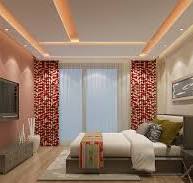Lighting has a significant impact on how we perceive space, particularly in bedrooms where creativity and tranquility coexist. LED bedroom ceiling design is more than simply a fad; it’s a synthesis of psychology, aesthetics, and science. We’ll look at how LED lighting theory can help you achieve the ideal atmosphere, energy efficiency, and aesthetic balance for your bedroom ceiling in this article.
Lighting is about mood, emotion, and design flow, not just brightness. The LED ceiling design for bedrooms concept turns typical bedrooms into calming, mood-enhancing areas by fusing lighting science with contemporary aesthetics. Using clever LED concepts, you may create the ideal environment for relaxation and renewal by striking a balance between comfort, functionality, and creativity.
Understanding the Theory Behind LED Ceiling Lighting
Three fundamental components of lighting theory serve as the foundation for the idea of LED ceiling design:
- Ambient Lighting: Provides general illumination throughout the room.
- Accent Lighting: Highlights architectural details or décor.
- Task Lighting: Offers focused light for specific activities like reading or dressing
Combining these layers with LED technology results in a lighting design that improves utility and mood. Key components of bedroom design psychology, like as brightness, warmth, and color temperature, may all be fully controlled with LEDs.
Why Choose LED Lights for Bedroom Ceilings?
Energy Efficiency and Long Lifespan
Compared to conventional bulbs, LEDs can save up to 80% on electricity use. This efficiency lowers heat production and energy costs for bedrooms that need soft, long-hour lighting.
Adjustable Mood Lighting
You can change your ceiling design from a bright morning setting to a serene nighttime glow with dimmers and sophisticated controls.
Eco-Friendly and Durable
LED lights are an environmentally friendly choice because they don’t contain mercury, produce very little UV light, and last for more than 25,000 hours.
Popular Types of LED Ceiling Designs for Bedrooms
False Ceiling LED Design
Recessed lights and strip LEDs concealed behind panels are used in a false ceiling LED design. This method produces a gentle, floating impression while evenly distributing light.
Cove Lighting
LEDs are installed by Cove Lighting in moldings or hollow nooks close to the ceiling edges. Perfect for modern or minimalist bedrooms, the indirect illumination creates a calming atmosphere as it reflects off walls.
Recessed Spot LEDs
Recessed spotlights provide focused illumination, making them ideal for emphasizing architectural details, wall art, or a headboard.
The Science of Light in Bedroom Design
Understanding how light impacts mood, sleep, and spatial perception is the foundation of the theory of LED ceiling design for bedrooms. Experts in lighting stress that light waves affect our circadian rhythm, which is the body’s internal clock that controls when we are awake and when we are asleep. Cooler LED tones above 4000K encourage activity and concentrate in bedrooms, while softer, warmer tones between 2700K and 3000K encourage relaxation. Homeowners can create an atmosphere that encourages restful evenings and revitalizing mornings by putting these ideas into practice. The versatility of LED technology allows you to effortlessly modify brightness, tone, and placement to fit your mood and the interior design of the space.
Combining Aesthetics and Function in LED Ceiling Design
A well-designed LED ceiling for a bedroom is both aesthetically pleasing and practical. In order to make lighting an imperceptible design feature that improves the overall atmosphere, illumination and architecture must be integrated. Cove lighting, suspended panel lights, and recessed LEDs all have distinct aesthetic and practical uses. For example, diffused cove lighting gives depth and warmth, and recessed LED strips concealed below ceiling borders give the appearance of floating. A balance between comfort and creativity is ensured by selecting neutral light shades for minimalist bedrooms or vibrant LED accents for contemporary interiors. Every design decision should have both aesthetic and functional purposes.
The Future of LED Ceiling Design in Bedroom Interiors
More intelligent, environmentally sustainable, and human-responsive solutions are the direction that LED ceiling design for bedrooms is taking. Ultra-thin flexible LED sheets for creative designs, dynamic panels that adapt to the weather, and biophilic lighting that replicates natural daylight cycles are examples of emerging trends. As interior psychology and lighting design combine, bedrooms will become customized wellness areas where each light beam is adjusted for efficiency, mood, and health.
Absolutely. LEDs use up to 80% less electricity than traditional bulbs and emit minimal heat, making them one of the most energy-efficient lighting solutions for bedrooms.
RGB LEDs are great for customizing color and ambiance. However, it’s best to include soft white or warm options to maintain a relaxing environment for sleeping.


1 thought on “LED Ceiling Design for Bedroom”